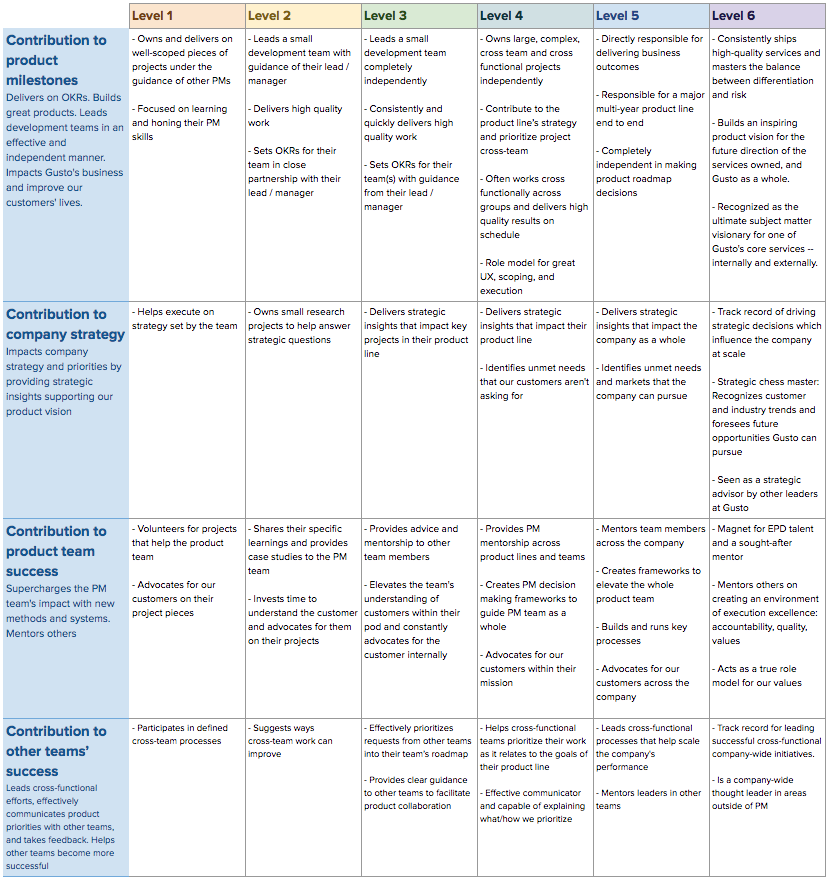When I first started managing product managers six years ago, I found it hard to provide my team with specific feedback to help them get to the next level in their careers. There’s no shortage of articles and blog posts about the different stages of a product management career, but they’re all based on titles (PM, Senior PM, Director of Product, etc.) and where people with these titles are located within an organization (Senior PMs report to Product Leads, and Product Leads report to Directors of Product, etc.). These articles almost never answer the key question of what, exactly, makes somebody ready to be a Director of Product vs. a Product Lead. What are the tangible skills they need to have in order to be successful at that next level? It’s even harder to go from giving advice on how to improve to being able to say how close or far one might be from a promotion.
At Gusto, we addressed this by breaking down product management into four key attributes. Each attribute has specific expectations for every stage of a product manager’s career, providing a map to managers and individual contributors alike.

The 4 Product Management Attributes
PMs at Gusto are evaluated on four attributes, each reflecting an area of potential impact.
Contribution to Product Milestones
This covers most of what one might consider the basics of a product manager role: managing a roadmap, writing specs, designing delightful user experiences, and prioritizing projects. Earlier in a product management career, this means delivering on well-scoped pieces of projects/features. Later on, it means managing multiple product lines with a proven track record of business results.
Contribution to Company Strategy
Product managers are responsible for driving insights across the business as a whole. Earlier in one’s career, a PM should understand and execute a strategy set by leadership while also owning small research projects. Later on, a PM should be delivering strategic insights that influence the entire company.
Contribution to Product Team Success
PMs should invest in the evolution of the team as a whole via mentorship, hiring, and the creation of new frameworks or processes. We expect this not only of people managers but also of individual contributors. One does not need to be a manager to help with recruiting, mentorship, or in general to be a leader.
Contribution to Other Teams’ Success
Product managers need to lead cross-functional efforts, effectively communicate product priorities with others, and take feedback. They should also be able to help with mentorship, recruiting, and processes outside of the core product management team, and be a leader in the company as a whole, helping other teams (such as engineering and design) be more successful.
Gusto’s PM Career Framework
At Gusto, we don’t have titles (you can learn more about that here). Instead, we map out careers by “levels” - each product manager has a level based on the scope of their role. Promotions occur when employees move from one level to the next. We don’t make the levels of specific employees public knowledge, but they are free to share if they so choose.
Each product management attribute is broken out by level, creating a rubric that can be used to evaluate how a product manager is performing. The rubric focuses on results, making it easy for both the PM and their manager to measure the PM’s contribution.

How to Use this Framework
Where and when to use it
Managers of PMs use the career framework at every step of a PM’s journey at Gusto.
- Evaluating candidates: When hiring, we gear our interview questions and the evaluation of those questions towards the expectations set in the career framework. For example, at Level 3, we expect PMs to be able to deliver meaningful strategic insights, and therefore we ask them more strategy-based questions in the interviews.
- Onboarding new hires: When new hires onboard to Gusto, we use the career framework to help them understand what we expect of them. Not only does this provide transparency, but it also helps the new hire identify his or her own strengths and weaknesses, giving them the opportunity to seek coaching from their manager in these specific areas.
- Performance reviews: Our biannual performance review process is centered around this framework. PMs evaluate themselves, managers evaluate their teams, and peers provide feedback to each other based on the attributes for each level. For example, I may ask the peers of a Level 3 PM to provide specific feedback with examples about how the PM was able to or not able to “Effectively prioritize requests from other teams into their team’s roadmap”. Career development plans are then created to help PMs improve in weaker areas while also leaning into and taking advantage of their strengths.
- Promotions: Promotions occur when a PM has been consistently performing at the attributes set for the next level up. As PMs grow in seniority, longer time periods are required to show consistency. For example, Level 5 PMs are expected to deliver business outcomes for Gusto for entire product lines, which takes many years.
How to use it
The career framework isn’t meant to be used by itself. People managers spend time with new hires to ensure they understand the it and then use it as the basis for career discussions throughout the year.
Additionally, we have internal documents that break down these attributes in even greater detail. For example, when we state that a Level 5 PM should “Mentor PM team members across the company”, we elaborate that this person should be able to hire, mentor, and retain PMs from Level 1 up to Level 5. We also provide concrete examples of what other PMs have done to illustrate the attributes at each level.
What if a PM is in between levels?
By design, most PMs will be in between the levels of our career framework. They will typically be meeting expectations for their current level and, over time, will show their ability to contribute at the next level. At the point where they are clearly and consistently able to perform at the next level across all PM attributes, they are promoted.
We bring new hires onto the team at the highest level at which they will perform effectively across all of the attributes. This way they are able to meet or beat our expectations, which avoids the situation in which somebody who is talented ends up disappointing a manager or peers who were expecting more (i.e. a PM who would be a superlative Level 2 is brought in at a Level 3 but not able to meet all of the Level 3 attributes).
Should I create a career framework for my team?
This is the easiest question of them all. The answer is Yes.
Building and maintaining a career framework is a lot of work, but here’s why it’s worth it:
- Transparency: Since the framework is shared for all to see, people can self-rate themselves and identify growth areas. It’s clear when people are ready for a promotion or when they have a bit more to go without their manager needing to tell them.
- Objectivity: Having clear criteria for promotions removes subjectivity from the promotion process and helps reduce unconscious bias, which levels the playing field for all people from all backgrounds.
- Consistency: All teams and managers use the same framework, which ensures that all employees are held to the same standards regardless of whom they report to.
- Time: As a manager, I’m constantly having career conversations with my team. Before we built our career framework, I found myself having the same conversations over and over, often with the same people. In the long run, creating the framework has saved me a huge amount of time.
Even if your team is small, having a clear career framework is worthwhile. On my team specifically, I have direct reports who aren’t PMs and are actually the only people in the company who perform their specific job function. I’ve created career frameworks specific to them, and while it was quite a bit of work, it has always paid off.
Build, Test, Iterate
We’ve iterated on our career framework over the course of the past four years, but there’s still a long way to go. What’s top of mind for us?
- Individual Contributor vs. Manager career tracks: Our career framework is intended to apply to both individual contributors and managers. However, we’ve gotten feedback that at senior levels, it would be helpful to split them up (often referred to as dual career tracks) to clarify expectations.
- More concrete examples: Something we’re experimenting with is an even longer-form version of our career framework that provides specific examples of contributions that meet each attribute. This makes the criteria less abstract, but also results in a document that is over a dozen pages long.

Want to Continue the Conversation?
I know that I’m not the only one who is passionate about product manager career development. If you’d like to develop your own career with Gusto, you can check out our open roles here.
I’d also love to hear from you - How do you develop the career of product managers at your company? How do you product manage your own career? Leave a message here or find me on LinkedIn.
Bio
Eric has been empowering product management teams at Gusto for the past four years. He loves building products that customers love, helping product managers grow, and making charcuterie.

